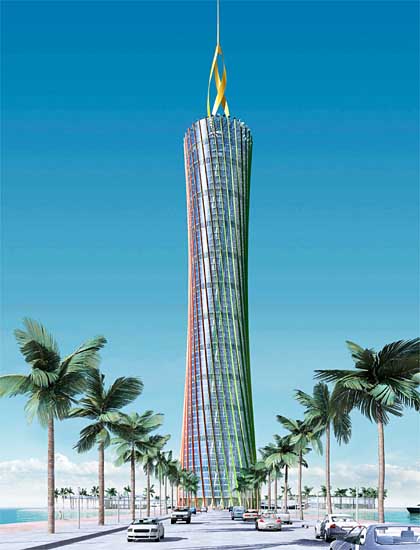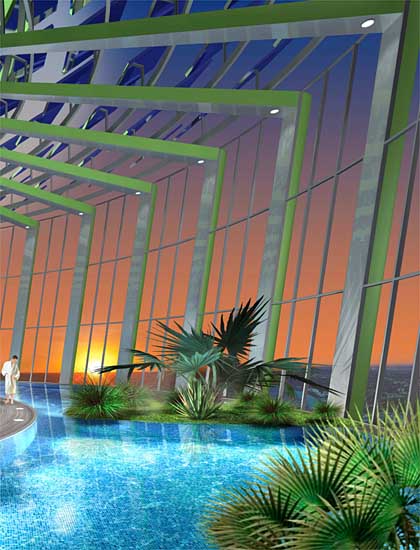
ECO-SKYSCRAPER - Burj al-Taqa

The planned €300 million Burj al-Taqa ("Energy Tower"), a giant 68-story building to rise to a lofty height of 322 meters (1,056 feet), will not just consume very little energy -- but it will also produce all of its own energy needs.
The Burj al-Taqa's cylindrical shape is designed to expose as little surface area to the sun as possible. A protective solar shield reaches from the ground to the roof, covering 60 degrees of the giant circular building. It protects the side most affected from the sun's glaring rays, making sure that none of the rooms are exposed to direct sunlight. The diffuse light on the other sides of the building is tempered by a mineral coating on the windows.
The tower's facade is to be built from a new generation of vacuum glazing that will only come on the market in 2008, transmitting as much as two thirds less heat compared to today's products.
The design by German architect Eckhard Gerber functions in a similar way as ancient Persian wind towers: The negative pressure created by winds breaking along the tower will suck the spent air from the rooms out of the building via air slits in the facade, while fresh air will be pumped into the interior of the building by means of a duct system.
Seawater will be used to pre-cool the air. Three large cooling units in the giant building's cellar will eventually lower the temperature to a comfortable 18 degrees Celsius (64.4 degrees Fahrenheit). Transparent ducts will channel the fresh air into spacious atriums and from there into the corridors and offices. The building's designers want to use high-quality steel ropes to suspend hanging gardens inside the air ducts, transforming a feature which is often regarded as an architectural blemish and hidden behind sheet metal in other buildings.
H owever
the most impressive feature of the building is that the operators of
the tower will not need to use any electricity from outside sources.
A 60-meter (197-feet) turbine on the tower roof and two photovoltaic
facilities with a total area of 15,000 square meters (161,459 square
feet) will produce sufficient electricity to meet the building's
needs. Additional energy is provided by an island of solar panels
with an area of 17,000 square meters (182,986 square feet), which
drifts in the sea within viewing distance of the tower.
owever
the most impressive feature of the building is that the operators of
the tower will not need to use any electricity from outside sources.
A 60-meter (197-feet) turbine on the tower roof and two photovoltaic
facilities with a total area of 15,000 square meters (161,459 square
feet) will produce sufficient electricity to meet the building's
needs. Additional energy is provided by an island of solar panels
with an area of 17,000 square meters (182,986 square feet), which
drifts in the sea within viewing distance of the tower.
The excess electricity will be used to obtain hydrogen from sea water by means of electrolysis. The hydrogen is then stored in special tanks. At night, the energy facility uses fuel cells to generate electricity, keeping the tower working through the hours of darkness. In the daytime, on the other hand, highly reflective mirrors on the roof direct the sunlight onto a cone of light that goes through the center of the building and provides its various floors with plenty of natural light.
http://www.spiegel.de/international/world/0,1518,481938,00.html
B4c_2